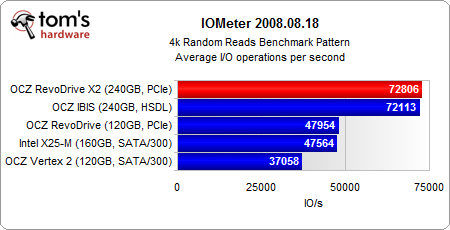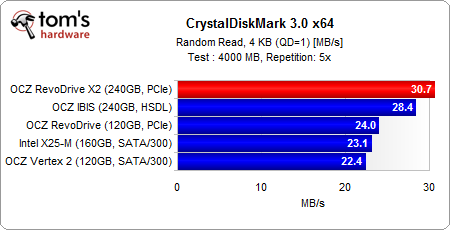OCZ’s RevoDrive X2: When A Fast PCIe SSD Isn’t Fast Enough
In a storage market where it's easiest to take one vendor's controller, another vendor's NAND flash, and put the two in a standard 2.5" SATA drive, OCZ continues innovating, giving IT professionals and power users more performance with its RevoDrive X2.
Benchmark Results: 4 KB And 512 KB Random Reads
Testing random read and write speed is perhaps most important for desktop usage models. Unless you’re doing heavy video editing, you’re probably not reading or writing a ton of sequential data to an SSD, after all.
The RevoDrive X2 and IBIS match each other’s performance in Iometer 4 KB random read performance. OCZ’s first-gen RevoDrive actually matches Intel’s second-gen X25-M. And the SandForce-based Vertex 2 falls into last place here.
The header of these two charts is the same, except for one important detail. The first employs a queue depth of one, and the second uses a queue depth of 32. Why are these figures important? Well, look what they do to performance.
Native Command Queuing, part of the SATA specification, was originally designed to improve the performance of mechanical disks by allowing the hard drive itself to optimize the order in which read and write commands get executed. Of course, the physics of a hard drive don’t apply to SSDs. However, the multi-channel architecture of a solid state drive enables it to similarly field multiple concurrent requests—though Intel claims the bottleneck isn’t the drive, but rather the host system itself. Today’s SSDs are consequently dependent on high queue depths in order to realize the specifications you see manufacturers quoting.
When OCZ says the RevoDrive X2 is best suited to environments heavy on I/O, this chart shows why the company means business. With a relatively non-taxing queue depth of one, the X2 takes a first place finish, but its 30.7 MB/s result is underwhelming, and certainly not very impressive compared to the last-place Vertex 2 at 22.4 MB/s.
Cranking queue depth up to the other (very unrealistic on the desktop) extreme queue depth of 32, the quad-controller RevoDrive X2 is suddenly pushing 466 MB/s, cruising past the IBIS at 434 MB/s. The dual-controller RevoDrive lags back at 210 MB/s, and Intel’s X25-M takes fourth place with 164 MB/s.
Get Tom's Hardware's best news and in-depth reviews, straight to your inbox.
Current page: Benchmark Results: 4 KB And 512 KB Random Reads
Prev Page Benchmark Results: CrystalDiskMark Streaming Performance Next Page Benchmark Results: 4 KB And 512 KB Random Writes-
eklipz330 although i think sandforce's new controller won't be as fast as they claim, i really think it's gonna change the face of the ssd race by the end of the yearReply
and probably a new iteration of the revodrive as well... can't wait!! =D =D i need me a 160gb for less than $1/gb... that's how much i bought my raptor for like 4 years ago!! -
cmi86 Yeah its really cool and i wish i had 1...or 2 lol but it just costs waay too much money, isnt really practical for enthusiast use until the prices dropReply -
dirtmountain You routinely use $500 graphic cards (GTX580) and $1,200 displays (2560x1600)in reviews. The price for this upgrade ($650)isn't any harder to stomach then those.Reply -
cangelini dirtmountainYou routinely use $500 graphic cards (GTX580) and $1,200 displays (2560x1600)in reviews. The price for this upgrade ($650)isn't any harder to stomach then those.Reply
Aye, but it's a little less tangible than exotic graphics configurations, too. -
alidan i realy wish they would put a 7200 10000 and 15000 drive in there, all top of their respective class, just so we can get some prospective of how much an improvement these are over traditional hdds.Reply




